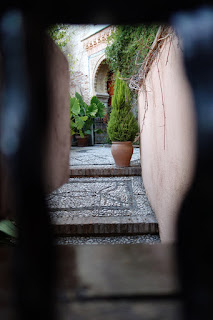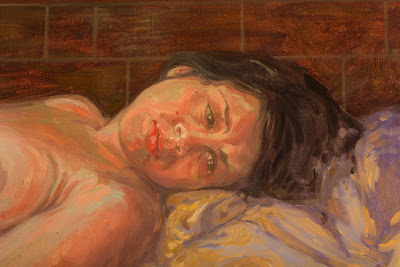Nicolas, the boys, and I drove from Granada to Cordoba for the day to see the Great Mosque of Cordoba. If you decide to drive like we did, do yourself a favor and don't try to drive all the way to the Mezquita through the Jewish quarter. Like El Albaisin in Granada, the Jewish Quarter is full of incredibly beautiful cobbled streets the exact width of a compact car (less its mirrors). Once we squeezed the car through, we had a wonderful time exploring the city.
The web of narrow streets lets out to a light filled plaza with the tall stucco wall that encases the Mezquita. It was a very interesting structure to approach, walking out of a dense forest and stumbling into Goldilock's tower out of the blue.
 We passed through a huge bronze door with lion head knockers. Through the gate, the space opens up to a vast Orange grove where the Moorish worshippers would come to wash their hands and feet before proceeding into the main hall to worship five times a day. The orange trees were actually imported by Prince And al-Rahman I when he escaped to Cordoba and made it his home after being driven out of Damascus.
We passed through a huge bronze door with lion head knockers. Through the gate, the space opens up to a vast Orange grove where the Moorish worshippers would come to wash their hands and feet before proceeding into the main hall to worship five times a day. The orange trees were actually imported by Prince And al-Rahman I when he escaped to Cordoba and made it his home after being driven out of Damascus.The Great Mosque has quite a complicated history. The site began as part of the Roman Empire as a temple (possibly for the Roman god Janus). In the 6th century, the Visigoths took control of Cordoba and built a basilica in its place. Muslims then built the grand Mosque of Cordoba over this basilica between the 8th and 12th centuries. Even during the breadth of the Moorish control of Cordoba, the Mosque was expanded several times. Cordoba was taken by Christian rule again in 1236, at which point, around half of the columns were destroyed to replace a basilica in the center of the newly re-converted mosque. Currently, you can see a mixture of the early Moorish architecture mixed with the standard Renaissance style architecture of the Christian cathedral.
What we are left with is an incredibly impressive, although occasionally puzzling building with over 900 beautiful horseshoe arches mixed with webbed vaulting and figural decorations of Christian saints (Representations of figures would have always been forbidden in a Mosque).
This is the original mihrab. It is not considered acceptable to include animorphic images within a Mosque or holy place, thus this holy space is decorated lavishly with geometric patterns, images of plants and vines, and beautifully gilded texts. The patterns are created in a mosaic with tiny tesserae made of glass with gold leaf backing. The imam would speak from this space. It is along the quibla wall and faces the Kaaba, the holiest of Muslim monuments, where every single follower of Islam prays five times a day.
The mihrab, where the Imam would speak would generally have a beautifully decorated mihrab dome above it. The acoustics of the room actually helped the Imam's message spread through the massive building.
The one thing I really enjoyed about the Christian renovations was the beams of light passing through the stained glass windows.
Hours and Info: 8 € entry fee
Monday-Saturday 10am-6pm, Sunday 8:30-11am
Hours and Info: 8 € entry fee
Monday-Saturday 10am-6pm, Sunday 8:30-11am
After an afternoon exploring Em Mezquita, we wandered back into the winding streets of the historic district to find Doble de Cepa, a wonderful cafe that I read about that serves authentic tapas with a side of live music in an atrium enclosed with a glass roof. We were the first ones to get there, and thought the place was closed, but as was the usual for our trip, fifteen minutes after we sat down, the restaurant filled up and the singing began! It was a lovely place.
A lovely gentleman, who did not speak English came by to help us order. We had planned on ordering a rice dish, but apparently the chef who cooks the rice dish was sick, and they do not serve sub-par dishes so they recommended a variety of other dishes. We ended up ordering the Pescaito frito, a dish of fried small fishes with a side of lemon, the Tortilla Espagnola (a Spanish Omlette with potato), and a tapa of Jamon (the cured ham). Despite being half portions, they were very plentiful, and with a full portion of the Rabo del Toro (bull tail stew with potatoes), we had more than enough for four! We split a bottle of house wine, a Rioja that was very lovely and quite inexpensive.
Doble de Cepa | Calle Martinez Rucher 9 | +34 957 94 46 73 | Monday-Sunday 9am-12am (Music starts between 2-3pm)
WHERE ELSE TO EAT?
Cafe-Taberna Luque | Calle Blanco Belmonte 4 | +34 699 80 65 60 | Amazing spanis food, Antonio helps you try - try oxtail - Make reservations!
Boraito Andalusi | Calle Lucano 19, Plaza del Porto | +34 633 78 61 55 | Wed-Mon 12:30pm-1am | tiny place, authentic, inexpensive Moroccan
Cerveas Califa | Calle Juan Valera 3 | +34 678 42 83 30 | Mon-Thur 11am-4pm, 7pm-2am Fri-Sat 11am-2am | Craft brewery, some good snacks
WHAT ELSE TO DO?
Alcazar de Los Reyes Cristianos | Tues-Fri 8:30am-8:45pm, Sat 8:30-4:30pm, Sun 8:30-2:30pm | 8 € entry fee, 2 € bell tower
Tablao Flamenco Cardenal | flamenco concert venue | Mon-Sat 9:30-11pm | 23 €
Archeological Enselble of Madinat Al-Zahara (en route to Seville) | Tues-Sat 9am-5:30pm, Sun 9am-3:30pm
10th century castle site of king who built the Mesquita

WHERE ELSE TO EAT?
Cafe-Taberna Luque | Calle Blanco Belmonte 4 | +34 699 80 65 60 | Amazing spanis food, Antonio helps you try - try oxtail - Make reservations!
Boraito Andalusi | Calle Lucano 19, Plaza del Porto | +34 633 78 61 55 | Wed-Mon 12:30pm-1am | tiny place, authentic, inexpensive Moroccan
Cerveas Califa | Calle Juan Valera 3 | +34 678 42 83 30 | Mon-Thur 11am-4pm, 7pm-2am Fri-Sat 11am-2am | Craft brewery, some good snacks
WHAT ELSE TO DO?
Alcazar de Los Reyes Cristianos | Tues-Fri 8:30am-8:45pm, Sat 8:30-4:30pm, Sun 8:30-2:30pm | 8 € entry fee, 2 € bell tower
Tablao Flamenco Cardenal | flamenco concert venue | Mon-Sat 9:30-11pm | 23 €
Archeological Enselble of Madinat Al-Zahara (en route to Seville) | Tues-Sat 9am-5:30pm, Sun 9am-3:30pm
10th century castle site of king who built the Mesquita































.jpg)

.jpg)






.jpg)